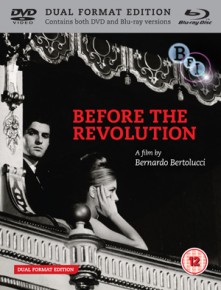Global Discoveries on DVD: About 40 More Items (or Thereabouts)
By Jonathan Rosenbaum
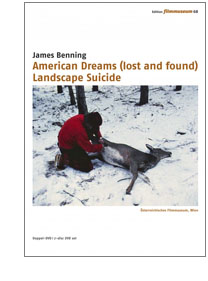 For its 68th DVD release, the Austrian Film Museum, which published the first substantial book about James Benning in 2007, has begun the long-overdue project of restoring and releasing Benning’s work by starting at the approximate halfway point of his filmography—namely American Dreams (lost and found) (1984, 53 min.) and Landscape Suicide (1986, 92 min.), in a two-disc set with a 20-page booklet, for 29,95 Euros. (Go to edition-filmmuseun.com for more details about this and their previous 67 DVD releases—though not about the 263-page book on Benning, which can be purchased for 25,99 from German Amazon.)
For its 68th DVD release, the Austrian Film Museum, which published the first substantial book about James Benning in 2007, has begun the long-overdue project of restoring and releasing Benning’s work by starting at the approximate halfway point of his filmography—namely American Dreams (lost and found) (1984, 53 min.) and Landscape Suicide (1986, 92 min.), in a two-disc set with a 20-page booklet, for 29,95 Euros. (Go to edition-filmmuseun.com for more details about this and their previous 67 DVD releases—though not about the 263-page book on Benning, which can be purchased for 25,99 from German Amazon.)
I haven’t yet seen American Dreams, but here’s my capsule review of Landscape Suicide for the Chicago Reader, written a quarter of a century ago: “All of James Benning’s features can be regarded as shotgun marriages in which he attempts to wed his distinctive formal talents and interests—framing Midwestern landscapes with beauty and nostalgia, using ambiguous offscreen sounds to create narrative expectations—with an intellectual or social rationale. Landscape Suicide (1986) was almost certainly his most successful and interesting foray in this direction since One Way Boogie Woogie (1977). Delving into two murder cases—Bernadette Protti’s seemingly unmotivated stabbing murder of another teenage girl in a California suburb in 1984, and Ed Gein’s even more gratuitous mass slayings and mutilations in rural Wisconsin in the late ‘50s—Benning uses actors to re-create part of the killers’ court testimonies and juxtaposes them with the commonplace settings where these crimes took place. Boldly eschewing the specious psychological rhetoric that usually accompanies accounts of such crimes, he creates an open forum for the spectator to contemplate the mysterious vacancy of these people and these places, and their relationships to each other. The performances of both actors, Rhonda Bell and Elian Sacker, are extraordinary achievements, and the chilling, evocative landscapes have their own stories to tell; the fusion of the two creates gaps that not even the film’s confusing title can fill, but the space opened up is at once powerful and provocative.”
***
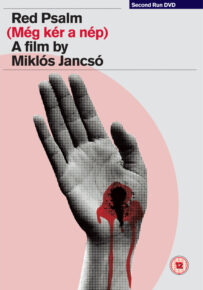 Another major release of the quarter: Miklós Jancsó’s dazzling, virtuoso Communist musical Red Psalm (1971) from Second Run in the UK—my probable favourite Jancsó film, although I estimate I’ve seen only about a third at most of his more than 30 features. (Other recent and worthy Second Run releases include Miguel Gomes’ Our Beloved Month of August [2008], which I’ve seen, and Jiří Menzel’s Larks on a String [1969], which I haven’t.) Part of what makes this edition of Red Psalm a particular standout, even though it’s already been available on a French DVD with English subtitles, is an excellent and extended contextualizing essay by Peter Hames that’s included in the accompanying booklet. Also included is the third and final installment of Jancsó’s 1994 documentary series Message of Stones, none of which I’ve seen yet; the first two parts were included as extras with the Second Run releases of Jancsó’s The Red and the White (1968, reportedly the best-selling item in their catalogue) and My Way Home (1964), respectively, while their edition of The Round-Up (1965) has an extended recent interview with Jancsó.
Another major release of the quarter: Miklós Jancsó’s dazzling, virtuoso Communist musical Red Psalm (1971) from Second Run in the UK—my probable favourite Jancsó film, although I estimate I’ve seen only about a third at most of his more than 30 features. (Other recent and worthy Second Run releases include Miguel Gomes’ Our Beloved Month of August [2008], which I’ve seen, and Jiří Menzel’s Larks on a String [1969], which I haven’t.) Part of what makes this edition of Red Psalm a particular standout, even though it’s already been available on a French DVD with English subtitles, is an excellent and extended contextualizing essay by Peter Hames that’s included in the accompanying booklet. Also included is the third and final installment of Jancsó’s 1994 documentary series Message of Stones, none of which I’ve seen yet; the first two parts were included as extras with the Second Run releases of Jancsó’s The Red and the White (1968, reportedly the best-selling item in their catalogue) and My Way Home (1964), respectively, while their edition of The Round-Up (1965) has an extended recent interview with Jancsó.
Incidentally, I don’t know whether or not this might have arisen from a copyediting oversight, but Raymond Durgnat, whose own remarkable essay about Red Psalm (at rouge.com.au/8/red_psalm.html) is appropriately cited several times in the Hames essay, is mentioned there only by his surname, unlike all the other critics referenced. I’d like to think that this is because he’s finally achieving some of the attention he’s long deserved: a brand-new web site devoted to him and his work, raymonddurgnat.com, is now receiving visitors.
***
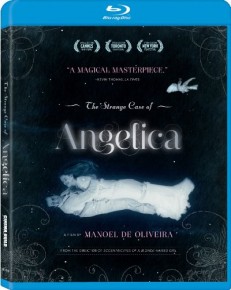 If I’m not mistaken, Manoel de Oliveira’s wonderful The Strange Case of Angelica (2010) is the first film of his to appear on Blu-ray. Cinema Guild makes it a major event in other respects as well, including among its extras a carefully mapped-out audio commentary by James Quandt; Oliveira’s first film, the silent Doiro, Faina Fluvial (1931); and Paulo Rocha’s Oliveira, l’Architecte, his fascinating 1992 contribution to Cinéma, de notre temps which treats us to glimpses of Oliveira’s early careers as a film actor and auto racer, and an interview that reveals the autobiographical source of Angelica about 18 years before that film was made.
If I’m not mistaken, Manoel de Oliveira’s wonderful The Strange Case of Angelica (2010) is the first film of his to appear on Blu-ray. Cinema Guild makes it a major event in other respects as well, including among its extras a carefully mapped-out audio commentary by James Quandt; Oliveira’s first film, the silent Doiro, Faina Fluvial (1931); and Paulo Rocha’s Oliveira, l’Architecte, his fascinating 1992 contribution to Cinéma, de notre temps which treats us to glimpses of Oliveira’s early careers as a film actor and auto racer, and an interview that reveals the autobiographical source of Angelica about 18 years before that film was made.
***
At jackieraynaldvds.blogspot.com, you can order Jackie Raynal’s New York Story (1981, 28 min.) and Hotel New York (1984, 53 min.) on a single PAL disc, “on demand,” for 30,00 Euros plus postage. These are actually alternate versions of the same zany, semi-autobiographical and surrealistic comedy, in both colour and black and white, co-starring Jackie and her late husband Sid Geffen, although the condition of the 16mm print used in the transfer of the first film, with a fair amount of colour scratches, is much poorer than the visual quality of the second. I play a cameo in the first as Charles Demerol, a pretentious Screen-style film analyst who quizzes Jackie after a screening of Deux fois (already available on the re:voir label), and other cameos or more substantial parts are played by the late Veronica Geng, Gary Indiana, Errol Morris, and Bérénice Reynaud (most or all of whom, like me, had a hand in writing her or his own dialogue). The great cinematographer Babette Mangolte (Chantal Akerman’s Jeanne Dielman, Sally Potter’s The Gold Diggers) shot both films.
***
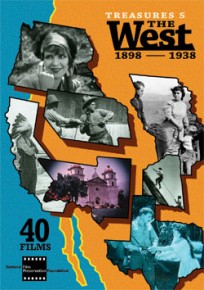 The fifth box set issued by the National Film Preservation Foundation, Treasures 5: The West, 1898-1938, containing three discs and a 110-page book, features 40 films, including work by D.W. Griffith, Mack Sennett, and Gregory La Cava, but since Clara Bow is my favourite Hollywood flapper, the first film I made a beeline for here is Victor Fleming’s Mantrap (1926), adapted from a now-forgotten Sinclair Lewis novel by two women, Ethel Doherty and Adelaide Heilbron, and reportedly much improved in the process. Up until now, I’d assumed that the flighty It, which Bow made the following year, was her probable masterpiece, while Children of Divorce, which she made just afterwards, is perhaps the dullest movie she ever appeared in, despite having Gary Cooper as her co-star (he also turns up in It) and Josef von Sternberg’s uncredited patch-up work. (Maybe it’s the relative lack of comedy that’s partly responsible.) But as wonderful as Bow is in It, Mantrap may well be her apotheosis—not only for the guiltless celebration of her transgressiveness as a compulsive flirt, which is comparable in some ways to the impudence of Brigitte Bardot in Roger Vadim’s …And God Created Woman (1956), transpiring here in both Minneapolis and the Canadian wilderness, but also for her sheer exuberance. (It’s also worth noting that she’s more adept than Bardot in dripping sex appeal from every pore without having to undress in order to prove it.) And according to the unsigned notes in this box set’s booklet, Bow herself once called it “the best silent picture I ever made.
The fifth box set issued by the National Film Preservation Foundation, Treasures 5: The West, 1898-1938, containing three discs and a 110-page book, features 40 films, including work by D.W. Griffith, Mack Sennett, and Gregory La Cava, but since Clara Bow is my favourite Hollywood flapper, the first film I made a beeline for here is Victor Fleming’s Mantrap (1926), adapted from a now-forgotten Sinclair Lewis novel by two women, Ethel Doherty and Adelaide Heilbron, and reportedly much improved in the process. Up until now, I’d assumed that the flighty It, which Bow made the following year, was her probable masterpiece, while Children of Divorce, which she made just afterwards, is perhaps the dullest movie she ever appeared in, despite having Gary Cooper as her co-star (he also turns up in It) and Josef von Sternberg’s uncredited patch-up work. (Maybe it’s the relative lack of comedy that’s partly responsible.) But as wonderful as Bow is in It, Mantrap may well be her apotheosis—not only for the guiltless celebration of her transgressiveness as a compulsive flirt, which is comparable in some ways to the impudence of Brigitte Bardot in Roger Vadim’s …And God Created Woman (1956), transpiring here in both Minneapolis and the Canadian wilderness, but also for her sheer exuberance. (It’s also worth noting that she’s more adept than Bardot in dripping sex appeal from every pore without having to undress in order to prove it.) And according to the unsigned notes in this box set’s booklet, Bow herself once called it “the best silent picture I ever made.
Mantrap has many other virtues apart from Bow, including cinematography by James Wong Howe and a wonderful performance by Eugene Pallette. Although It is often remembered fondly for an immortal line of dialogue delivered in a department store (by a fellow clerk to Bow), “Hot socks! The new boss!” this comedy grants Bow at least three slangy comebacks of her own that are even better: “Gee, you always pick out the worst crumbs in the bakery!” “If you could fish as well as you can crab, there’d be many an empty lake up here,” and finally and simply, “Minneapple-sauce!” So I wound up watching much of this movie twice—the second time to follow it with Michael Sragow’s excellent audio commentary. (There are many other optional audio commentaries in this package, by the way, including a couple by Tom Gunning with the Griffith and Sennett shorts.)
***
A correction of an error in my last column is in order. I described Tian Zhuangzhuang’s 2004 feature Delamu—a spectacular landscape documentary about a trade route between Yunnan province and Tibet—as being, like Tian’s more recent and rather embarrassing The Warrior and the Wolf (2009), “another Chinese-Japanese coproduction,” and one that remains “woefully unavailable on DVD with any Western subtitles.” But I now possess a version with French and Dutch subtitles from freerecordshop.nl, so if you can read subtitles in either of these languages, I highly recommend checking this sucker out.
***
Hey guys, out of all the possible candidates out there, do we really and truly need a Blu-ray of Pasolini’s Salò (1975), recently released by Criterion? Just asking. And assuming that we do need it, what do we need it for?
Clearly Criterion’s Blu-ray of both versions of Bergman’s Fanny and Alexander (1982) has much more of a point to it; even if some of Bergman’s most vocal American fans have yet to see the uncut TV serial—the only version that Bergman himself stood by, which was already on the Criterion DVD—having it now on Blu-ray gives them (and me, for that matter) even less of an excuse for ignoring it.
***
 Memo to the English subtitler of Chantal Akerman’s trilingual (Spanish, English, and French, roughly in that order) 2002 masterpiece From the Other Side, recently released by Icarus Films: the plural of “roof” is “roofs,” not “rooves.” Even if the subtitler were trying to approximate faulty Spanish, which I doubt, any error of this kind that calls attention to itself should be discouraged as an unnecessary distraction. Nevertheless, even without any extras or any subtitles apart from those in English, this DVD is a treasure, all the way up through the beautiful and haunting final monologue by Akerman in French, bringing to a climax her poetry of absence as well as her politics of lament; and it’s good to know that Akerman’s even greater D’Est (1993) is available on the same label.
Memo to the English subtitler of Chantal Akerman’s trilingual (Spanish, English, and French, roughly in that order) 2002 masterpiece From the Other Side, recently released by Icarus Films: the plural of “roof” is “roofs,” not “rooves.” Even if the subtitler were trying to approximate faulty Spanish, which I doubt, any error of this kind that calls attention to itself should be discouraged as an unnecessary distraction. Nevertheless, even without any extras or any subtitles apart from those in English, this DVD is a treasure, all the way up through the beautiful and haunting final monologue by Akerman in French, bringing to a climax her poetry of absence as well as her politics of lament; and it’s good to know that Akerman’s even greater D’Est (1993) is available on the same label.
***
Apart from an appearance in October 2010 at Robert Koehler’s Anaheim International Film Festival, Peter Thompson’s mind-boggling Lowlands (2009)—a highly original fictional essay about war, domesticity, the life and work of Vermeer, the fate of Vermeer’s widow, and recent crimes against humanity—which I’ve been touting for some time (see, especially, “A Handful of World: The Films of Peter Thompson, An Introduction and Interview,” in the Fall 2009 Film Quarterly and at jonathanrosenbaum.com/?p=27534), finally premiered in Chicago about a year later, and Peter released his beautifully realized DVD of the film, available at his own website (chicagomediaworks.com), at the same event. It’s packed with extras, and Peter’s own relaxed audio commentary, an unstuffy and fact-filled lecture laced with personal details, is fascinating.
***
Two more Françoise Romand releases, both NTSC and all-region, which you can order for 20 Euros each via PayPal: Thème Je aka The Camera I (2004), recently revised and still her most daring film, included with her first short film Rencontres aka Intersections (1977); and her new, half-hour Gais Gay Games, filmed at the August 2010 “Gay Olympics” in Cologne. Go to romand.fr for more details.
***
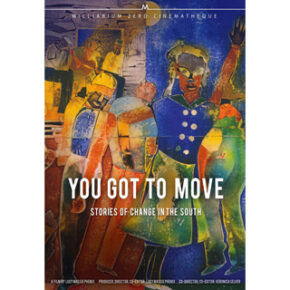 I missed Lucy Massie Phenix’s 1985 documentary about Highlander Folk School, You Got To Move: Stories of Change in the South, when it came out. But as an alumnus of the second and final session of Highlander’s six-week co-ed and interracial Youth Camp in 1961—not long before the state of Tennessee shut down its Monteagle headquarters (and, as legend has it, even burnt them to the ground), forcing director Myles Horton and others to shift their base of operations to another part of the state—I obviously had to see this, and it didn’t let me down. To this day, I respect Highlander more than any other educational institution I’ve ever been affiliated with, either as a student or as a teacher, and my only (personal) disappointment here is that no account of the Youth Camp in either 1960 or ‘61 is included. But given how rich and various Highlander’s example has been since the ‘30s, this is certainly forgivable, and among the interviewees filmed here, I’m especially grateful for the grace and wisdom of singer Bernice Johnson Reagon, who, like many of the others, including Horton, can be seen in subsequent interviews included in the extras, which pursue the Highlander story up to the near-present. What emerges is a history of Southern activism that most people still know very little about, despite a couple of books about Highlander and Horton that are already on my shelves. Thanks once again to Dennis Doros at Milestone Film & Video/Milliarium Zero for making an overlooked part of our history available.
I missed Lucy Massie Phenix’s 1985 documentary about Highlander Folk School, You Got To Move: Stories of Change in the South, when it came out. But as an alumnus of the second and final session of Highlander’s six-week co-ed and interracial Youth Camp in 1961—not long before the state of Tennessee shut down its Monteagle headquarters (and, as legend has it, even burnt them to the ground), forcing director Myles Horton and others to shift their base of operations to another part of the state—I obviously had to see this, and it didn’t let me down. To this day, I respect Highlander more than any other educational institution I’ve ever been affiliated with, either as a student or as a teacher, and my only (personal) disappointment here is that no account of the Youth Camp in either 1960 or ‘61 is included. But given how rich and various Highlander’s example has been since the ‘30s, this is certainly forgivable, and among the interviewees filmed here, I’m especially grateful for the grace and wisdom of singer Bernice Johnson Reagon, who, like many of the others, including Horton, can be seen in subsequent interviews included in the extras, which pursue the Highlander story up to the near-present. What emerges is a history of Southern activism that most people still know very little about, despite a couple of books about Highlander and Horton that are already on my shelves. Thanks once again to Dennis Doros at Milestone Film & Video/Milliarium Zero for making an overlooked part of our history available.
***
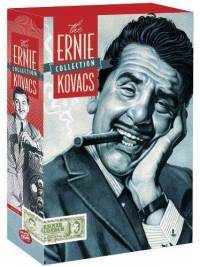 I’m not sure how this happened, but I managed to miss the innovatory brilliance of Ernie Kovacs on TV (1951-1962) while I was growing up, so acquiring the six-disc Ernie Kovacs Collection has been a major source of wonder and delight for me. Put together with a lot of obvious care, this set testifies to a time when it was possible to be (radically) avant-garde and (mundanely) mainstream at the same time on television, as strange as that now seems. This was also arguably the case with some live broadcast dramas on Studio One and Playhouse 90, but all we have left of those moments now are faint echoes, because they’re no longer live but embalmed. (See my comments about Criterion’s The Golden Age of Television, especially The Comedian, in Cinema Scope 41 for more on this subject.) In the case of Kovacs, the screwball originality alone keeps them alive and challenging.
I’m not sure how this happened, but I managed to miss the innovatory brilliance of Ernie Kovacs on TV (1951-1962) while I was growing up, so acquiring the six-disc Ernie Kovacs Collection has been a major source of wonder and delight for me. Put together with a lot of obvious care, this set testifies to a time when it was possible to be (radically) avant-garde and (mundanely) mainstream at the same time on television, as strange as that now seems. This was also arguably the case with some live broadcast dramas on Studio One and Playhouse 90, but all we have left of those moments now are faint echoes, because they’re no longer live but embalmed. (See my comments about Criterion’s The Golden Age of Television, especially The Comedian, in Cinema Scope 41 for more on this subject.) In the case of Kovacs, the screwball originality alone keeps them alive and challenging.
***
Le Beau Serge and Les Cousins (Criterion). Years ago, in the Chicago Reader, when called upon to write a capsule review of Chabrol’s first feature Le Beau Serge (1958), I “confessed” that “I barely remember it,” and DVD Beaver recently reproduced this remark in its coverage of the Criterion Blu-ray. But now I’m embarrassed to discover that I’d never seen the film at all until now, which makes me all the more surprised that I’ve never read anything about the film’s highly eccentric score by Émile Delpierre, with its seemingly gratuitous employment of unexpected jolts of music to punctuate moments when nothing of any particular importance is happening.
 It’s too bad that two of the more thoughtful contemporary treatments of the film by critics who had seen it are not readily accessible: Roland Barthes’ uncollected and (I believe) still untranslated Mythologies essay, “Cinéma droite et gauche,” in the 11 mars 1959 Lettres Nouvelles, is chiefly an attack on the film for what Barthes views as its right-wing ideology (“a right-wing art, always interested in the discontinuity of human troubles, never in what connects them”), after briefly praising its “micro-realism.” (I suspect that Chabrol’s most famous polemical essay, “Little Themes,” published in Cahiers du Cinéma about half a year after Barthes’ attack, was conceived at least in part as a response to it.)
It’s too bad that two of the more thoughtful contemporary treatments of the film by critics who had seen it are not readily accessible: Roland Barthes’ uncollected and (I believe) still untranslated Mythologies essay, “Cinéma droite et gauche,” in the 11 mars 1959 Lettres Nouvelles, is chiefly an attack on the film for what Barthes views as its right-wing ideology (“a right-wing art, always interested in the discontinuity of human troubles, never in what connects them”), after briefly praising its “micro-realism.” (I suspect that Chabrol’s most famous polemical essay, “Little Themes,” published in Cahiers du Cinéma about half a year after Barthes’ attack, was conceived at least in part as a response to it.)
I’ve already translated much of the rest of his argument in my 1983 essay about Barthes and film, so I won’t belabour it here. But it seems worth quoting at least a paragraph from Raymond Durgnat’s more mixed entry on Le Beau Serge in his long-unavailable 1963 monograph Nouvelle Vague: The First Decade, which for me represents Durgnat at his near-best (which also means at his most ethically advanced, especially for 1963):
“Commenting, quite rightly, on the moral beauty of friendship in Le Beau Serge, the Free Cinema Group seem concerned to defend it against criticism as being ‘merely’ sublimated homosexuality. But does it matter whether François and Serge are sublimated homosexuals or not? To be pedantic, all friendships between men are sublimated homosexuality, but even if this friendship is the result of an unusually strong and imperfectly sublimated homosexual feeling, i.e. homosexuality with bells on, I don’t see how this would make their feelings for each other any the less precious or worth our concern and respect. Indeed, there is a link with the current artistic disinterest in ‘character analysis.’ Many moods are unanalysable because they only exist as a complex of other feelings—just as green exists only as a synthesis of yellow and blue. Hence for most purposes, analysis precludes (or at least hinders) a lyrical sensibility, i.e. the evocation of feelings as felt, i.e. the experience of living.”
And, as long as I’m on the subject of the Great Digresser, let me digress long enough to point out that on his audio commentary to Les Cousins, Adrian Martin cites some other portions from Nouvelle Vague: The First Decade.
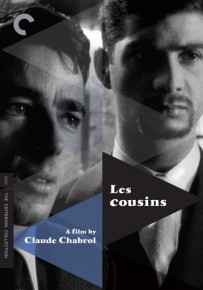 Frankly, I don’t much care for Le Beau Serge now that I’ve seen it, because I find neither of the male heroes convincing or compelling. But once I go on to re-see Les Cousins (1958), with the same two actors, Gérard Blain and Jean-Claude Brialy, playing the two leads, I find it even more complex and interesting than I did when I first saw it, as a teenager in Manhattan—enough so, in fact, that I pass directly to Chabrol’s Que la bête meure (1969), still available on DVD from pathfinderpictures.com/video, which I find also holds up rather well, and similarly illustrates Chabrol’s argument that he was more of a Langian in some ways than a Hitchcockian. (Among its many memorable facets is its villain—the bête of the title, played by Jean Yanne—who is conceivably the most monstrous and odious asshole that Chabrol’s favourite screenwriter, Paul Gégauff, ever helped to dream up, although Claude Cerval’s Clovis in Les Cousins certainly gives him a run for his money.) This later film can arguably be read as Chabrol’s most Catholic film after Le Beau Serge, although it assumes that position with a certain amount of ambivalence insofar as the hero’s climactic confession to the heroine, that he has been having a long-term affair with her simply as part of an elaborate scheme to avenge the accidental death of his son, is intercut throughout with the elaborate carving and serving of a duck at a gourmet restaurant, implying a furious tug of war between Chabrol’s serious moral preoccupations and his equally serious sensual/culinary appetites. (Curiously, this duck never gets mentioned by either Robin Wood or Michael Walker in their excellent book about early Chabrol, perhaps because its Buñuelian irony in this context doesn’t sit too well with the film’s other concerns.) Martin’s audio commentary on Les Cousins, by the way, is pretty good about both Gégauff and the many similarities between Chabrol and Fassbinder in terms of their preoccupations with sadism and personal power struggles, although I wish he’d pointed out that the former director, unlike the latter one, never claimed to be a leftist dedicated to the betterment of society. (The jury may still be out regarding Gégauff, at least if one judges by his performance of a Mozart piano sonata and brief lecture to farmhands in Godard’s Week End [1967].)
Frankly, I don’t much care for Le Beau Serge now that I’ve seen it, because I find neither of the male heroes convincing or compelling. But once I go on to re-see Les Cousins (1958), with the same two actors, Gérard Blain and Jean-Claude Brialy, playing the two leads, I find it even more complex and interesting than I did when I first saw it, as a teenager in Manhattan—enough so, in fact, that I pass directly to Chabrol’s Que la bête meure (1969), still available on DVD from pathfinderpictures.com/video, which I find also holds up rather well, and similarly illustrates Chabrol’s argument that he was more of a Langian in some ways than a Hitchcockian. (Among its many memorable facets is its villain—the bête of the title, played by Jean Yanne—who is conceivably the most monstrous and odious asshole that Chabrol’s favourite screenwriter, Paul Gégauff, ever helped to dream up, although Claude Cerval’s Clovis in Les Cousins certainly gives him a run for his money.) This later film can arguably be read as Chabrol’s most Catholic film after Le Beau Serge, although it assumes that position with a certain amount of ambivalence insofar as the hero’s climactic confession to the heroine, that he has been having a long-term affair with her simply as part of an elaborate scheme to avenge the accidental death of his son, is intercut throughout with the elaborate carving and serving of a duck at a gourmet restaurant, implying a furious tug of war between Chabrol’s serious moral preoccupations and his equally serious sensual/culinary appetites. (Curiously, this duck never gets mentioned by either Robin Wood or Michael Walker in their excellent book about early Chabrol, perhaps because its Buñuelian irony in this context doesn’t sit too well with the film’s other concerns.) Martin’s audio commentary on Les Cousins, by the way, is pretty good about both Gégauff and the many similarities between Chabrol and Fassbinder in terms of their preoccupations with sadism and personal power struggles, although I wish he’d pointed out that the former director, unlike the latter one, never claimed to be a leftist dedicated to the betterment of society. (The jury may still be out regarding Gégauff, at least if one judges by his performance of a Mozart piano sonata and brief lecture to farmhands in Godard’s Week End [1967].)
Two further chapters in revisiting early Chabrol: Le Boucher (1969) and La Rupture (1970), both available from pathfinderpictures.com/video and both with audio commentaries by screenwriters Howard Rodman and Terry Curtis Fox, joined by F.X. Feeney on the second of these. Regarding the second: ever since I saw this silly, over-the-top Manichean melodrama during its first run in Paris, I’ve regarded it as a preposterous, outlandish hoot—unlike most of my colleagues, who generally seem to take it quite seriously. (This includes the so-called homage to the trolley sequence in Sunrise [1927], which strikes me as being even more absurdly irrelevant to its model than De Palma’s allusion to Eisenstein’s Odessa Steps sequence in The Untouchables [1987].) But at least Curtis, Feeney, and Rodman are pretty light-hearted in the way they express their seriousness about it, with the result that I ultimately find their commentary more enjoyable than the film itself. (P.S. I didn’t make it all the way through this film and this commentary, but I believe the commentators are unaware that part of this film’s ending is derived from a late, unrealized Fritz Lang project that Chabrol tried to broker with his frequent producer, André Génovès, involving both an LSD trip and multi-coloured balloons; see the final pages of Lotte Eisner’s Fritz Lang for more details about this.)
As for Le Boucher, which I still regard as one of Chabrol’s finest films (along with Les Bonnes Femmes [1960] and La Cérémonie [1995]), Rodman and Fox are mostly equal to the task of explaining, in careful detail, what’s so good about it. My only quibbles are with one misattribution (crediting Robin Wood with Michael Walker’s intriguing comparison of Le Boucher with Cocteau’s La Belle at la Bête [1946]), and their tendency, once again, to overstress Hitchcock’s influence on Chabrol and underplay the greater influence of Lang (apart from their passing acknowledgment of M [1931] as a cross-reference). It’s too bad they weren’t around when Chabrol showed Le Boucher at the New York Film Festival and corrected this misimpression himself.
Before the Revolution (BFI). Sometimes it takes a new DVD for me to properly appreciate an extra feature that’s on an older one. So even though I can’t play them in BFI’s new dual-format set (because it’s for Region 2 Blu-ray players only), I can hugely enjoy Giuseppe Bertolucci’s interviews with his older brother, editor Robert Perpignani, cinematographer Vittorio Storaro, and composer Ennio Morricone, most or all of which was already available on an Italian DVD of Before the Revolution (1964) with optional English subtitles that was released a few years ago. I’m especially grateful for Giuseppe’s comments about identifying with the younger brother in the final scene of Bernardo’s second feature (for me, still his best), which Bernardo acknowledges with a smile, and for Perpignani spelling out how the editing of one sequence steals fairly directly from the editing of a sequence in L’année dernière à Marienbad (1961). (It’s worth noting how often Bernardo Bertolucci mentions Godard as an influence and how seldom he mentions Resnais.) But to be fair, this BFI release has many more extras, including a 12-minute interview with Bernardo Bertolucci held by David Thompson at BFI Southbank in early 2011.
***
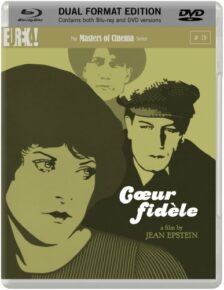 Coeur fidèle (Masters of Cinema). Here’s another English dual-format edition whose Region B Blu-ray my setup can’t handle, but no matter: just on DVD, this glorious rendering of Jean Epstein’s second feature (1923) positively glistens. There are no less than 33 references to this film in the index of Richard Abel’s indispensable French Cinema: The First Wave, 1915-1929, and that’s not even counting the detailed eight-page analysis he accords to it, which gives you some notion of the film’s importance, although apart from La chute de la maison Usher (1928), it’s the first Epstein feature I’ve ever seen on disc. The story’s an old-fashioned melodrama that Epstein turned to as a commercial pretext for an exercise de style (Abel cross-references his strategy and reasoning with that of Flaubert in writing Madame Bovary), including his Gance-inspired experiments with rapid montage (most famously during a carnival-ride sequence), but this commercial reasoning didn’t exactly pan out: Abel reports that the film was an abysmal flop at the box office. But 88 years later, Coeur fidèle is very watchable (the compositions are very elegant, by the way), and Masters of Cinema has done a very creditable job with it, on all counts.
Coeur fidèle (Masters of Cinema). Here’s another English dual-format edition whose Region B Blu-ray my setup can’t handle, but no matter: just on DVD, this glorious rendering of Jean Epstein’s second feature (1923) positively glistens. There are no less than 33 references to this film in the index of Richard Abel’s indispensable French Cinema: The First Wave, 1915-1929, and that’s not even counting the detailed eight-page analysis he accords to it, which gives you some notion of the film’s importance, although apart from La chute de la maison Usher (1928), it’s the first Epstein feature I’ve ever seen on disc. The story’s an old-fashioned melodrama that Epstein turned to as a commercial pretext for an exercise de style (Abel cross-references his strategy and reasoning with that of Flaubert in writing Madame Bovary), including his Gance-inspired experiments with rapid montage (most famously during a carnival-ride sequence), but this commercial reasoning didn’t exactly pan out: Abel reports that the film was an abysmal flop at the box office. But 88 years later, Coeur fidèle is very watchable (the compositions are very elegant, by the way), and Masters of Cinema has done a very creditable job with it, on all counts.
***
A decade has passed since Gaumont released L’intégrale DVD Jean Vigo in France, which it reissued in 2008, and Artificial Eye meanwhile brought out its own modified and simplified version with English subtitles in the UK in 2004. So the Criterion two-disc set The Complete Jean Vigo has been a long time in 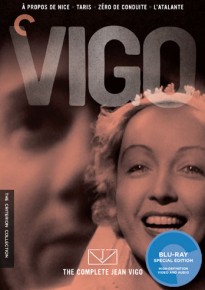 coming, but to be fair about it, this is more than a simple duplication of either the French or the English versions. Among the more significant additions are fact-filled audio commentaries on all the films by the judicious English film scholar Michael Temple (who points out, just for starters, the little-known fact that À propos de Nice [1930] was actually co-directed by Vigo and Boris Kaufman), essays by Michael Almereyda, B. Kite, Robert Polito, and Luc Sante, and a short animated “tribute” to Vigo by Michel Gondry (charming, although the relevance of this to Vigo, apart from a recurring barge, escaped me). I can’t recall whether or not the English edition included Eric Rohmer’s 1968 interview with François Truffaut about L’Atalante (1934), which I’ve just seen for the first time. I appreciate Truffaut’s astuteness about the film’s improvisations, the fact that the story is about a couple (and not really about a barge), the probable influence exerted by Renoir’s 1932 Boudu sauvé des eaux (with a no less brilliant Michel Simon performance), and the film’s carnal impact. But I regret his statement that Vigo was the first “professional” avant-garde filmmaker, which consigns Jean Epstein and Marcel L’Herbier to oblivion far too readily and unnecessarily, even though I would concede that Vigo was a greater filmmaker in many respects than either of them. (In passing, Truffaut does cite L’Herbier’s much later La nuit fantastique [1942], made during the Occupation, as a fantasy that, unlike Vigo’s, is insufficiently grounded in a sense of reality; it’s easy enough to see what he means, although I must confess that my own reading of that film makes it an invaluable time capsule about the Occupation precisely because of everything that it represses, with an overall sense of helplessness and impotence shining through.)
coming, but to be fair about it, this is more than a simple duplication of either the French or the English versions. Among the more significant additions are fact-filled audio commentaries on all the films by the judicious English film scholar Michael Temple (who points out, just for starters, the little-known fact that À propos de Nice [1930] was actually co-directed by Vigo and Boris Kaufman), essays by Michael Almereyda, B. Kite, Robert Polito, and Luc Sante, and a short animated “tribute” to Vigo by Michel Gondry (charming, although the relevance of this to Vigo, apart from a recurring barge, escaped me). I can’t recall whether or not the English edition included Eric Rohmer’s 1968 interview with François Truffaut about L’Atalante (1934), which I’ve just seen for the first time. I appreciate Truffaut’s astuteness about the film’s improvisations, the fact that the story is about a couple (and not really about a barge), the probable influence exerted by Renoir’s 1932 Boudu sauvé des eaux (with a no less brilliant Michel Simon performance), and the film’s carnal impact. But I regret his statement that Vigo was the first “professional” avant-garde filmmaker, which consigns Jean Epstein and Marcel L’Herbier to oblivion far too readily and unnecessarily, even though I would concede that Vigo was a greater filmmaker in many respects than either of them. (In passing, Truffaut does cite L’Herbier’s much later La nuit fantastique [1942], made during the Occupation, as a fantasy that, unlike Vigo’s, is insufficiently grounded in a sense of reality; it’s easy enough to see what he means, although I must confess that my own reading of that film makes it an invaluable time capsule about the Occupation precisely because of everything that it represses, with an overall sense of helplessness and impotence shining through.)
Two particularly welcome carryovers from the original Gaumont edition are Jacques Rozier’s 1964 documentary about Vigo for Cinéastes, de notre temps and Bernard Eisenschitz’s 2001 documentary about the separate versions and outtakes of L’Atalante. The first of these is especially valuable for its personal recollections about the pre-production (including the casting), production, and reception of both Zéro de conduite (1933) and L’Atalante; I’m particularly fond of the account of the former film’s premiere, where André Gide walked out before the end and shook the hand of one of the film’s supporters in the lobby as if he were commiserating with a family member at a funeral—which reminded me of the mainly disastrous reception the film had when I showed it at the Gene Siskel Film Center three years ago as part of a World Cinema of the ‘30s course and film series, which for me demonstrated how radical the film remains over half a century later. Rozier’s section about L’Atalante, incidentally, which includes interviews with all of the film’s major actors, appears to contradict Truffaut’s presumption that Simon’s character Père Jules already existed in some form in the original script.
***
 Elisabeth Marton’s Swedish film in German, My Name Was Sabina Spielrein (2002), has recently been released by Facets Video (which, I’m sorry to say, persists in prefacing all its releases with an exceedingly dumb and patronizing introductory bit about callow Americans who don’t know how to pronounce “Cannes”—something that wasn’t even funny the first time I saw it, much less the umpteenth). This widescreen documentary with re-enactments about Jung’s first patient—a Russian Jew who went on to become not only his mistress but also a psychoanalyst in her own right and an associate of Freud, who later founded an innovative and controversial school in Stalinist Russia and was eventually shot by Nazis—is rightly being promoted as an important preface to David Cronenberg’s A Dangerous Method, which I’ve subsequently seen and liked. This was my introduction to an important figure whom Freudian history has tended to paper over, so I’m immensely grateful to Marton as well as to Cronenberg for helping to bring this material to light (or at least to my attention).
Elisabeth Marton’s Swedish film in German, My Name Was Sabina Spielrein (2002), has recently been released by Facets Video (which, I’m sorry to say, persists in prefacing all its releases with an exceedingly dumb and patronizing introductory bit about callow Americans who don’t know how to pronounce “Cannes”—something that wasn’t even funny the first time I saw it, much less the umpteenth). This widescreen documentary with re-enactments about Jung’s first patient—a Russian Jew who went on to become not only his mistress but also a psychoanalyst in her own right and an associate of Freud, who later founded an innovative and controversial school in Stalinist Russia and was eventually shot by Nazis—is rightly being promoted as an important preface to David Cronenberg’s A Dangerous Method, which I’ve subsequently seen and liked. This was my introduction to an important figure whom Freudian history has tended to paper over, so I’m immensely grateful to Marton as well as to Cronenberg for helping to bring this material to light (or at least to my attention).
***
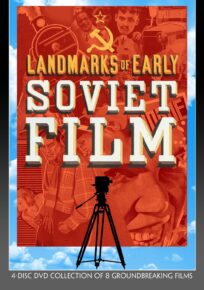 Landmarks of Early Soviet Film (Flicker Alley). This four-disc set contains many important treasures, a few of which I still haven’t seen: Lev Kuleshov’s The Extraordinary Adventures of Mr. West in the Land of the Bolsheviks (1924) and By the Law (1926), Dziga Vertov’s Stride, Soviet! (1926), Esfir Shub’s The Fall of the Romanov Dynasty (1927), Boris Barnet’s The House on Trubnaya (1928), Vuktor Turin’s Turksib (1929), and Sergei Eisenstein’s Old and New (1929). The order here is mainly chronological, but I’ve saved the probable best for last because, frankly, Eisenstein’s earthy and delirious rural poem has given me more pleasure than his far better known 1928 October (aside from the bridge-raising sequence and a few other privileged moments).
Landmarks of Early Soviet Film (Flicker Alley). This four-disc set contains many important treasures, a few of which I still haven’t seen: Lev Kuleshov’s The Extraordinary Adventures of Mr. West in the Land of the Bolsheviks (1924) and By the Law (1926), Dziga Vertov’s Stride, Soviet! (1926), Esfir Shub’s The Fall of the Romanov Dynasty (1927), Boris Barnet’s The House on Trubnaya (1928), Vuktor Turin’s Turksib (1929), and Sergei Eisenstein’s Old and New (1929). The order here is mainly chronological, but I’ve saved the probable best for last because, frankly, Eisenstein’s earthy and delirious rural poem has given me more pleasure than his far better known 1928 October (aside from the bridge-raising sequence and a few other privileged moments).
***
My Chicago Reader capsule review of Leningrad Cowboys Go America: “Aki Kaurismäki’s flaky one-note comedy from Finland (1989) about an eight-piece Finnish band with weird hairdos and shoes that tours the American and Mexican boondocks. A reasonably enjoyable (if occasionally  monotonous) piece of conscious camp, with Matti Pellonpää and Kari Väänänen; director and hipster-in-arms Jim Jarmusch puts in a brief cameo.” Now that Eclipse, for its 29th release, has combined this feature with Kaurismäki’s Leningrad Cowboys Meet Moses, Total Balalaika Show (both 1994), and five Kaurismäki-directed music videos with the same release, I suspect we now have an over four-hour one-note comedy. For comparable Finnish humour, I’m reminded of my visit to Helsinki, when Aki and his brother Mika took me and several other guests to their Moscow Bar, apologizing all the while to us for the fact that the sandwiches there were fresh.
monotonous) piece of conscious camp, with Matti Pellonpää and Kari Väänänen; director and hipster-in-arms Jim Jarmusch puts in a brief cameo.” Now that Eclipse, for its 29th release, has combined this feature with Kaurismäki’s Leningrad Cowboys Meet Moses, Total Balalaika Show (both 1994), and five Kaurismäki-directed music videos with the same release, I suspect we now have an over four-hour one-note comedy. For comparable Finnish humour, I’m reminded of my visit to Helsinki, when Aki and his brother Mika took me and several other guests to their Moscow Bar, apologizing all the while to us for the fact that the sandwiches there were fresh.
***
Soon after I arrived in San Sebastian to serve on the New Directors jury, I picked up Víctor Erice’s La morte rouge (2006) on the Rosebud label at FNAC, and watched this 33-minute masterpiece with English subtitles soon afterwards, for the first time, in my hotel room. It’s my wholly unexpected good luck that the principal location of this autobiographical essay about the first movie Erice ever saw, Roy William Neill’s The Scarlet Claw (a creepy 1946 Sherlock Holmes opus dubbed into Spanish), is the Kursaal, visible from my room—a one-time casino (until gambling was outlawed) that also housed an ornate cinema. (The French title refers to the imaginary French Canadian town where The Scarlet Claw is set.)
There are many other things about this film that kept me spellbound: not just the sumptuous beauty and mystery of the (mainly black-and-white) images and the entrancing rhythm of their succession, but the uncanny closeness of Erice’s childhood experience to my own first book, Moving Places: A Life at the Movies, whereby the mix of newsreel and fantasy conjures up an indelible sense of contemporary actuality (in Erice’s case, postwar Franco Spain). I was also fascinated by the recurring Spanish theme of perceiving the Franco period through the metaphor and vehicle of horror films that’s also evident in Pere Portabella’s Cuadecuc-Vampir, Umbracle (both 1970), and the beginning of his Informe general (1977), not to mention Erice’s own The Spirit of the Beehive (1973).
On the same disc, among a rich profusion of extras, is Erice’s 11-minute Alumbramiento/Lifeline (2002), also in black and white, his fictional contribution to the sketch feature Ten Minutes Older: The Trumpet—in some ways even more ambitious and jam-packed, albeit much less immediately accessible, at least to me. (Linda Ehrlich’s detailed essay about it, “The Promise of Time”—another extra, also included in the second edition of her invaluable collection, An Open Window: The Cinema of Víctor Erice—offers a lot of useful contextual information.) There’s also a 53-minute conversation between Erice and Manuel Asin included, and everything comes with optional English, French, and Spanish subtitles.
***
Also at the FNAC store in San Sebastian, I was surprised to discover how many obscure American features are available that one would be less likely to find in the US. Less obscure and more notable are an affordable DVD of Sternberg’s 1932 El Expreso de Shanghai (aka Shanghai Express), along with relatively inexpensive versions of Robert Wise’s 1954 La Torre de Los Ambiciosos (aka Executive Suite), Peter Godfrey’s 1947 Las Dos Señoras Carroll (aka The Two Mrs. Carrolls), and Raoul Walsh’s 1956 Un Rey para Cuatro Reinas (aka The King and Four Queens). I’ve recently tried to watch the melodramatic Godfrey film (a turkey, made especially ludicrous by a hectoring Alex North score that periodically shrieks with overwrought climaxes) and re-seen the Walsh, a rather static, offbeat CinemaScope Western that’s partially redeemed by great set design and Clark Gable, Eleanor Parker, and Jo Van Fleet in their primes (along with Barbara Nichols, Jean Willes, Sara Shane, and, arguably, Jay C. Flippen in relative bimbo parts).
On another recent trip, thanks to Bloomington resident James Naremore, I managed to land an English-subtitled version of one of my all-time favourite French noirs (and, arguably, the very first), Jean Renoir’s 1932 La nuit du Carrefour (1932), on a homemade label calling itself Video Dimensions, with Douglas Fairbanks’ The Mystery of the Leaping Fish (1916) included as an extra. The last time I tried to Google this release, it appeared to have vanished somewhere in cyberspace, but maybe you’ll have better luck in finding it there than I did.
***
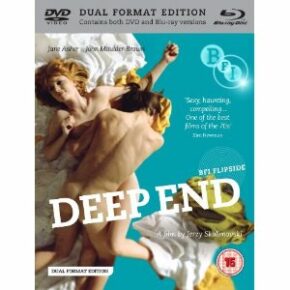 I used to harbour the bias that Jerzy Skolimowski’s first manic comedy feature about adolescent erotic frenzy with John Moulder-Brown, Deep End (1970), was critically overrated whereas his second, King, Queen, Knave (1972), was underrated. Having recently re-seen and much enjoyed the first of these in the BFI’s dual-format edition, I’m no longer as sure about this, and until the latter appears on DVD, we won’t have a basis for a proper comparison anyway. Both films, I hasten to add, were shot in Bavarian studios—perhaps even the same Bavarian studio—but Deep End does a pretty swell job of hiding this fact.
I used to harbour the bias that Jerzy Skolimowski’s first manic comedy feature about adolescent erotic frenzy with John Moulder-Brown, Deep End (1970), was critically overrated whereas his second, King, Queen, Knave (1972), was underrated. Having recently re-seen and much enjoyed the first of these in the BFI’s dual-format edition, I’m no longer as sure about this, and until the latter appears on DVD, we won’t have a basis for a proper comparison anyway. Both films, I hasten to add, were shot in Bavarian studios—perhaps even the same Bavarian studio—but Deep End does a pretty swell job of hiding this fact.
***
The good news: Go to FNAC.es, look up Yuma in the DVD section, and you’ll find that you can purchase Samuel Fuller’s otherwise unavailable Run of the Arrow (1957) for only 6,99 Euros. The bad news: believe it or not, the cost of postage, if you live in the US, is 32,46 Euros.
***
In Brussels last fall, I picked up three more features by my favourite Belgian surrealist apart from Chantal Akerman, André Delvaux (1926-2002), whose Rendez-vous à Bray (1971), memorialized in an exquisite box set that I wrote about in my 13th column, is a particular delight: namely, Belle (1973), Benvenuta (1983), and L’oeuvre au noir (1988), all released by cinematek.be, with some other titles in the works. The two other Delvaux films I’ve now seen are L’homme au crâne rasé (1965, also available from the same source), which I admire more than like, and Un soir, un train (1968), a masterpiece that isn’t available on DVD, although it can be downloaded from various sources. Cinematek also advertises a Collection Delvaux with still more stuff (e.g., the 1979 Femme entre chien et loup, and a bonus DVD with shorts and a documentary) at a cheaper price, available by subscription so that you get sent two features a year and the promise of a “complete” set by the end of 2012. (You can also order their terrific two-disc Avant-Garde 1927-1937 set and a Henri Storck Collection, among other things.)
Armed with Frédéric Sojcher’s brief but excellent André Delvaux, le cinema ou l’art des rencontres, I’m presently inching my way through the Delvaux filmography chronologically, and am still digesting the diverse puzzlements of Belle, with the full understanding that without some of these, any Delvaux feature would feel incomplete. (As Sojcher points out, even though he and painter Paul Delvaux were unrelated, there’s a dream-sequence image in Belle featuring a nude woman on a railroad platform at night that clearly evokes many of the latter’s canvases.) Most Delvaux features are adaptations, but Belle is the only one with an original script that he wrote single-handedly.
***
 The first two features of Matt Porterfield—Hamilton (2006) and Putty Hill (2011), both scriptless dramas about working-class teenagers in suburban Baltimore—have been issued together with many extras in a two-disc box by Cinema Guild. I saw and was mightily impressed by the second of these at South by Southwest in Austin in early 2010, and the fact that it’s been dated a year later might mean that it opened commercially in 2011, or else that it’s been subsequently revised. Either way, I join Salon’s Andrew O’Hehir and The New Yorker’s Richard Brody, both of whom contributed essays to this set, in applauding Porterfield’s debut.
The first two features of Matt Porterfield—Hamilton (2006) and Putty Hill (2011), both scriptless dramas about working-class teenagers in suburban Baltimore—have been issued together with many extras in a two-disc box by Cinema Guild. I saw and was mightily impressed by the second of these at South by Southwest in Austin in early 2010, and the fact that it’s been dated a year later might mean that it opened commercially in 2011, or else that it’s been subsequently revised. Either way, I join Salon’s Andrew O’Hehir and The New Yorker’s Richard Brody, both of whom contributed essays to this set, in applauding Porterfield’s debut.
***
The latest insult to the memory of Orson Welles is the Citizen Kane Blu-ray issued by Warners (the “70th Anniversary Ultimate Collector’s Edition” that includes The Magnificent Ambersons [1942] on a DVD without extras as a bonus), which I paid for out of my own pocket. This doesn’t mean that I’m advising you not to buy it, necessarily; after all, it does look pretty good, and it does includes optional Czech, English, French, Hungarian, Portuguese, Russian, and Spanish subtitles. My main objections, such as they are, are as follows:
a. A monument to the Pauline Kael factoid that Citizen Kane is a studio film and not an independent film made with studio resources, this edition also includes, on two separate discs, the lamentable and untrustworthy The Battle Over Citizen Kane (1996) and RKO 281 (1999), if only to underline where its heart (and money) lie. I still haven’t been able to bring myself to watch all of the latter, which is why it’s barely mentioned in my 2007 book Discovering Orson Welles. But I can’t forget that Film Comment once commissioned a review of the latter while refusing to commission a review of the now out-of-print 2000 release of the TV series Around the World with Orson Welles—an actual work by Welles, and one previously unseen and unreleased in the US, as opposed to a piece of uninformed studio self-congratulation using the Welles myth as grease for its industry wheels. There’s also a souvenir program, a lavishly illustrated hardcover booklet, and 15 detachable cards that include several ads for the film, a letter from RKO executive George Schaefer to Welles, a Blue Ribbon award, the title page from what appears to be another souvenir booklet, and a few studio documents. There are also audio commentaries by Roger Ebert and Peter Bogdanovich and interviews with Robert Wise and Ruth Warrick that I would expect to be far more reliable than The Battle Over Citizen Kane and/or RKO 281, clearly made by and for the folks who want to stick with the myths.
b. It’s bad enough that Ambersons isn’t a Blu-ray and contains no extras (though I still harbour some hopes that some or all of Robert Carringer’s superb extras on the Ambersons laserdisc will some day turn up on a DVD). What’s truly unforgivable are the boorish placements of the chapter divisions—one of which, believe it or not, occurs right in the middle of my favourite shot in the film, the entrance to the Ambersons ball near the beginning, which has the effect of dissing the film’s most exquisite visual detail as being irrelevant to what it construes to be the “narrative.” Thanks a lot, guys, for giving me insights into what is and isn’t important in the film. When aesthetic indifference reaches this level of obtuseness—comparable, in my experience, only to the awful DVD of Shirley Clarke’s The Connection (1961) that places some of its chapter breaks in the middle of some of the musical numbers—it becomes difficult to ignore.
***
Pedro Costa has alerted me to the belated appearance on DVD of two of my favourite Straub-Huillet films, The Bridegroom, the Comedienne and the Pimp (1968, perhaps the richest of their short films) and Operai, contadini (2000, perhaps the most sensual of their landscape films), along with Othon (1969) and five recent shorts, on volume six (three discs) of Danièle Huillet et Jean-Marie Straub on Editions Montparnasse; he’s also clarified that the non-appearance so far of another favourite landscape film, Trop tôt, trop tard (1982), is due to difficulties in assembling the proper elements for a transfer. For details about the five previous volumes (including Costa’s own films about Huillet and Straub, as well as some other documentaries about their work, in addition to their 1977 Toute révolution est un coup de dés, on volume five), go to editionsmontparnasse.fr; be forewarned that, as far as I can tell, the only subtitles to be found here are in French.
***
I don’t have the American edition of The Savage Eye (1960), from Image Entertainment, co-signed by Ben Maddow, Sidney Meyers, and Joseph Strick, which Amazon sells for $26.99, but I now have the comparably pricey French DVD released by Carlotta Films, and it includes a 16-minute interview with Strick that clarifies various production and preproduction details (such as the fact that Maddow basically wrote the script and Meyers basically did the editing while Strick basically directed—although he doesn’t talk about the particular material shot by Jack Couffer, Helen Levitt, and/or Haskell Wexler). Both the American and French DVDs include Strick’s 1970 Interviews with My Lai Victims, which won an Oscar, but Amazon doesn’t mention the 16-minute interview and, because it’s made in France, I assume the US DVD doesn’t include it.
The French DVD of Bresson’s Un condamné à mort s’est échappé (1957) from Gaumont works from a restored master, has English (and French) subtitles, and includes both a new, 44-minute talking-head documentary about the film and the original trailer (which is both interesting and very Bressonian), neither of which is subtitled.
Jonathan Rosenbaum
